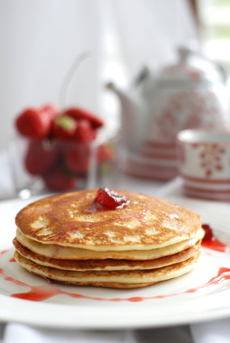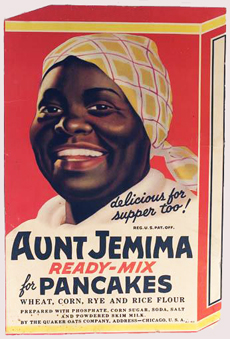

From cooking outdoors on a hot rock in a fire to elegant dining on fine porcelain, pancakes have spanned millennia and class distinctions. Photo by Elena Kor | IST.
STEPHANIE ZONIS focuses on good foods and the people who produce them.
|
November 2009
|
 |
Best Pancake Mixes: Whole Grain & Multigrain
Page 2: Pancake Definition & History
This is Page 2 of a 6-page article, plus 18 pages of product reviews. Click the black links below to view other pages.
Pancake Definition & History
My Webster’s New Collegiate Dictionary defines a pancake as “a flat cake made of thin batter and cooked (as on a griddle) on both sides.” Today, basic pancakes in the U.S. are usually made of flour (or a blend of flours), a leavening agent (sometimes more than one), fat, a liquid and flavoring (salt, vanilla, etc.); eggs are a frequent addition, as well. Though not tested here, add-ins, which range from fruit to bacon bits to chocolate chips, are common.
In one form or another, people have been eating pancake-like foods for a very long time. According to Alan Davidson, in the Oxford Companion to Food (Oxford University Press, Oxford: 1999), the first mention of anything other than just a bread baked on a griddle is in Apicius, who talks about cakes from a batter of eggs, milk, water and flour. These cakes were fried and served with both pepper and honey. An English culinary manuscript from the early 15th century mentions pancakes in a way that implies that the term was already an established one, but references to “pancakes” are not common in early printed cookbooks.
Foodtimeline.org notes that pancakes became especially popular for Shrove Tuesday in European countries where Catholicism predominated. Shrove Tuesday is the day before Lent begins. Since consumption of both eggs and fat was forbidden by the Catholic Church during the forty days of Lent, Shrove Tuesday became an occasion to use up one’s stores of both items. In England during the medieval era, the custom of Shrove Tuesday pancake races began. The race still held in Olney is said to have been held almost annually for more than five hundred years.
Types Of Pancakes
Pancakes have taken many forms all over the world, including crepes, Irish boxty, potato pancakes or latkes, Russian blini, the Welsh crempog, Indian poori, Hungarian palascinta and Dutch pannenkoeken (sometimes called “Dutch babies”). You’ll find many different pancakes in our Pancake Glossary—they go from A (arepa) to Z (zucchini pancakes).
While various forms of pancakes are eaten at different times of the day, pancakes have been an important breakfast item in the New World since long before the establishment of the United States. In colonial America, cornmeal pancakes were called “Indian cakes,” and the colony of Rhode Island became particularly well-known for Johnnycakes, also called “journey cakes.” Hotcakes made with buckwheat were called “buckwheat cakes” or simply “buckwheats.” The word “pancake” seems to be more modern, not appearing in the U.S. until the late 19th century.
The Dawn Of The Pancake Mix
Cooks would mix up pancakes from flour, baking powder (leavening), butter (shortening), salt, eggs and milk. The first pancake mix—in fact, the first real convenience mix in this country—was Aunt Jemima,* introduced in 1889 by what was then the Pearl Milling Company. Although one might think that the typical housewife would be happy to be spared measuring out the messier dry ingredients, the product was not an instant hit.
*While the name was taken from a character in a minstrel show, it is Biblical in origin; Jemima was the eldest of Job’s daughters.
R.T. Davis bought the struggling milling company in 1890, and introduced a woman named Nancy Green as the Aunt Jemima spokeswoman. Ms. Green (who was actually born into slavery in 1834), signed an exclusive contract, giving her the right to portray the character for the rest of her life; she remained active until she was struck by a car in 1923, at the age of 89.
Ms. Green did pancake demonstrations with the mix—most notably at the World’s Columbian Exposition in Chicago in 1893—that proved so popular that the company was renamed the Aunt Jemima Mills Company in 1914. The Quaker Oats Company bought Aunt Jemima Mills in 1926. Aunt Jemima Pancake Mix is still produced today. Aunt Jemima is a huge brand name, but now has much more competition. |
|

A box of Aunt Jemima pancake mix after the company’s purchase by Quaker Oats. |
Continue To Page 3: Pancake Mix Preparation
Go To The Article Index Above
Lifestyle Direct Direct, Inc. All rights reserved. Images are the copyright of their respective owners.
|



